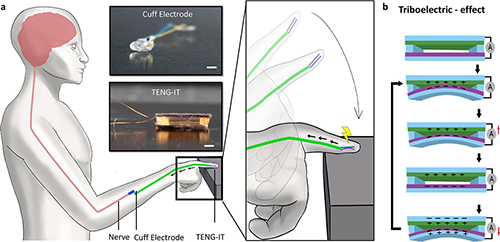| Jul 01, 2021 | |
Triboelectric nanogenerators to the rescue if you lose your sense of touch |
|
| (Nanowerk Spotlight) Dozens of research groups worldwide are developing variations of the triboelectric nanogenerator (TENG), a device that converts ambient mechanical energy into electricity. | |
| Triboelectric nanogenerators use a combination of the triboelectric effect and electrostatic induction to generate small amounts of electrical power from mechanical motion such as rotation, sliding or vibration. The triboelectric effect takes advantage of the fact that certain materials become electrically charged after they come into moving contact with a surface made from a different material. | |
| The electricity generated by TENGs could replace or supplement other power sources such as batteries or supercapacitors for powering wearable electronics, sensor networks, implantable medical devices and other small systems. Read more in our Nanowerk Spotlight here: "Triboelectric nanogenerators for next-generation wearable health monitoring". | |
| Some research groups working on TENGs are focusing on biomedical applications, an area with numerous and exciting possibilities. One recent example in this field is an in vitro and in vivo proof-of-concept for the capacity of TENG technology to function as a simple, scalable, inexpensive, and self-powered device for tactile sensory restoration. | |
| The results have been published in ACS Nano ("Restoring Tactile Sensation Using a Triboelectric Nanogenerator"). | |
| "Today, there is much room for development in the design of implanted devices aimed at restoring tactile sensation," Ben M. Maoz, a Principal Investigator in the Department of Biomedical Engineering, and Sagol School of Neuroscience at Tel Aviv University, tells Nanowerk. "In addition to overcoming the shortcomings of current and emerging technologies, such a device should ideally fulfill several criteria – biocompatibility; durability, flexibility and small footprint; wide range of sensitivity corresponding to normal human pressure perception; and simplicity of design and implantation." | |
| In this work, Maoz and his team created an integrated tactile (IT) sensory restoration device (TENG-IT) that powers itself and is suitable for implantation, and demonstrated its functionality in vivo. | |
 |
|
| Illustration of the TENG-IT. a. Use of TENG-IT for restoring tactile sensation. The TENG-IT is implanted under the skin (e.g., of a desensitized finger). Upon application of tactile pressure to the device, the TENG-IT generates an electrical signal, which is delivered using isolated cables to a stimulating cuff electrode wrapped around the closest undamaged afferent nerve fiber, which transduces a touch sensation signal to the CNS. Upper inset: top: Photo of a cuff electrode (scale bar: 1 mm); bottom: Photo of a TENG-IT device (scale bar: 1 mm; a larger version than the device used in our experiments is pictured for clarity of presentation). b. Schematics of the TENG, which converts mechanical energy into electricity using the triboelectric effect. (Reprinted with permission by American Chemical Society) (click on image to enlarge) | |
| To design and fabricate their TENG-IT device, the researchers chose polydimethylsiloxane (PDMS) as the negatively charged dielectric material, and tested nylon and cellulose acetate butyrate as the positively charged layer – all flexible and biocompatible materials. For the metal electrode, they used a thin layer of gold, which was evaporated onto a microscale layer of Kapton for stability. | |
| In an animal experiment, the team confirmed their device's capacity to bypass a damaged nerve and activate sensory neurons – specifically mouse dorsal root ganglia – at various levels of electrical potential, generated by different levels of tactile pressure on the implanted TENG-IT. | |
| After these successful demonstrations, the team's next goal is to translate the results into clinical trials. However, as Maoz points out, to further adapt the TENG-IT device for medical use, several additional developments are required: In addition to further device miniaturization (it currently measures about 24 mm2), the implantation procedure could benefit from refinements, taking into account the part of the body in which the device is to be implanted, the configurations of damaged and healthy nerves in the area, and the quantity of sensory neurons connected to the nerve. | |
| Once the development reaches human trials, the output adjustment needs to be fine-tuned so that it matches the natural feeling of sensation of the wearer. | |
| "And finally" concludes Maoz, "though we tested the durability of our device over half a million taps and in simulated biological conditions over 26 days, it is necessary to verify the long-term stability and functionality of the TENG-IT device in vivo, and to adjust its design as necessary. It should ideally be possible for the device to function for many years after implantation without the need for replacement." | |
 By
Michael
Berger
– Michael is author of three books by the Royal Society of Chemistry:
Nano-Society: Pushing the Boundaries of Technology,
Nanotechnology: The Future is Tiny, and
Nanoengineering: The Skills and Tools Making Technology Invisible
Copyright ©
Nanowerk LLC
By
Michael
Berger
– Michael is author of three books by the Royal Society of Chemistry:
Nano-Society: Pushing the Boundaries of Technology,
Nanotechnology: The Future is Tiny, and
Nanoengineering: The Skills and Tools Making Technology Invisible
Copyright ©
Nanowerk LLC
|
|
|
Become a Spotlight guest author! Join our large and growing group of guest contributors. Have you just published a scientific paper or have other exciting developments to share with the nanotechnology community? Here is how to publish on nanowerk.com. |
|
